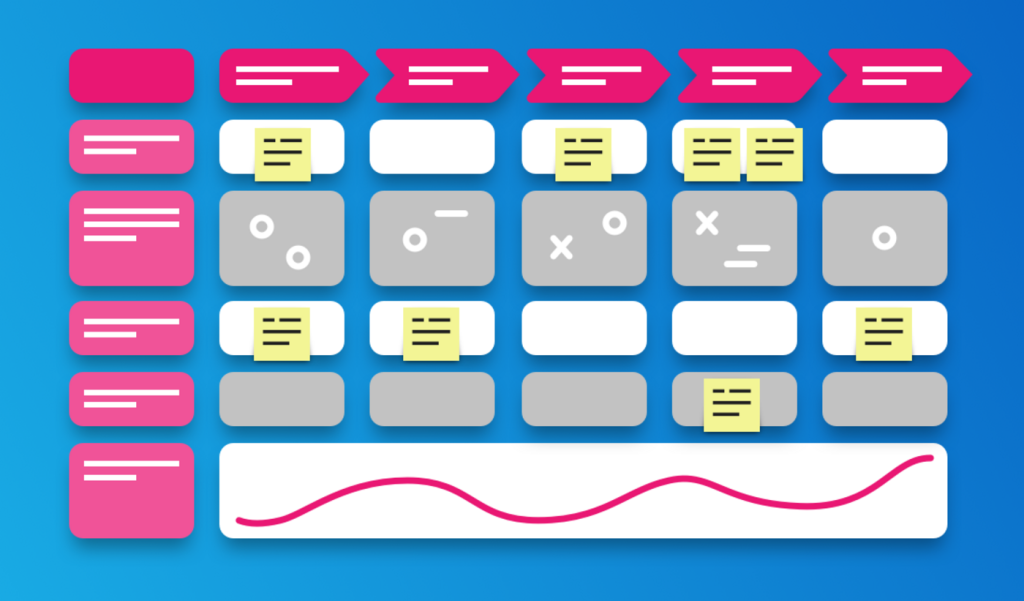User Journey Mapping
User Journey Mapping: A blueprint for Customer Success
User Journey Mapping is an essential practice in Customer Success Management (CSM), providing a visual and strategic representation of the customer’s experience with a product or service. By systematically identifying customer touchpoints, creating customer personas, mapping milestones, and defining success metrics, organizations can better understand and enhance the customer journey. This process not only aligns the company’s efforts with customer needs but also ensures that every interaction contributes to long-term success and satisfaction.

Table of content
Identifying customer touchpoints
The first step in user journey mapping in Customer success management, is identifying all the touchpoints where customers interact with the product, service, or company. These touchpoints are critical because they represent moments when the customer forms impressions, makes decisions, or encounters challenges. Always consider what the customer might be feeling at given touchpoints and what the customer desires.
- Pre-Sales Touchpoints
Before a customer makes a purchase, they engage with the company through various channels, such as marketing campaigns, social media, and website visits. These pre-sales touchpoints are crucial for setting expectations and building initial trust. Understanding where and how potential customers engage during this stage allows the organization to create a seamless transition from interest to acquisition. - Onboarding Touchpoints
Once a customer has committed to a purchase, the onboarding process begins. This phase includes everything from signing contracts to setting up accounts and receiving initial training. Onboarding touchpoints are vital for ensuring that customers start their journey on the right foot. A well-designed onboarding process reduces friction, accelerates time-to-value, and sets the stage for long-term engagement. - Product Usage Touchpoints
During the ongoing usage phase, customers interact with the product or service regularly. These touchpoints include daily interactions with the software, customer support queries, and any self-service options available. Understanding product usage touchpoints helps in identifying areas where customers may need additional support or where they are experiencing the most value. - Support and Feedback Touchpoints
Customers may require support or choose to provide feedback at various stages of their journey. These touchpoints include interactions with customer support teams, participation in surveys, and engagement in community forums. Effective management of these touchpoints ensures that customers feel heard and valued, fostering a positive relationship and encouraging continued use. - Renewal and Expansion Touchpoints
As the customer approaches the end of their initial contract, renewal touchpoints come into play. These moments are critical for assessing satisfaction and identifying opportunities for upselling or cross-selling additional products or services. Mapping these touchpoints ensures that the customer is continually engaged and sees the ongoing value in maintaining and expanding their relationship with the company.
Creating customer personas
Creating customer personas is a foundational step in understanding the diverse needs, behaviors, and goals of different customer segments. Personas are fictional representations of typical customers, based on data and insights gathered from real interactions.
- Defining Personas
Personas should be detailed and include information such as demographics, job roles, motivations, challenges, and preferred communication channels. For example, a persona might describe a “Tech-Savvy Operations Manager” who values efficiency and is focused on improving workflow automation within their organization. - Segmenting Customers
Different personas may represent various segments of the customer base, each with unique needs and expectations. By segmenting customers into these personas, organizations can tailor their strategies to meet specific requirements. For instance, a “Cautious Financial Officer” might require more detailed ROI analysis before committing to expansion, while a “Growth-Oriented Marketing Executive” might be more interested in innovative features that drive customer acquisition. - Aligning Touchpoints with Personas
Once personas are defined, it’s important to align customer touchpoints with these personas. Understanding how different personas interact with the product or service at each touchpoint enables the organization to personalize the customer experience, making it more relevant and effective. - Updating Personas Over Time
Customer personas should not be static. As the customer base evolves, so too should the personas. Regularly revisiting and updating personas ensures that they remain accurate and reflective of current customer behaviors and needs.
Mapping customer milestones
Mapping customer milestones involves identifying key moments in the customer journey that signify progress, value realization, or potential challenges. These milestones serve as guideposts, helping both the customer and the organization understand where they are in the journey and what steps are next.
- Onboarding Milestones
The onboarding phase typically includes several critical milestones, such as account setup, initial training completion, and first successful use of the product. These milestones are important for building momentum early in the customer relationship and ensuring that the customer quickly experiences value.
Learn more about Onboarding and Implementation
- Adoption Milestones
As customers begin to use the product regularly, adoption milestones track their engagement and proficiency. This might include achieving a certain level of usage, integrating the product into daily workflows, or reaching a predefined outcome that aligns with their initial goals.
Learn more about User Adoption
- Growth Milestones
For ongoing customers, growth milestones might involve expanding usage to new departments, adding additional features or modules, or reaching a key performance indicator (KPI) that demonstrates significant ROI. These milestones indicate that the customer is deriving increasing value from the product and is likely to consider renewal or expansion opportunities. - Support Milestones
Support milestones are linked to customer satisfaction and retention. Key moments include resolving a major issue, receiving a high satisfaction rating after a support interaction, or participating in a user community event. These milestones help gauge the customer’s overall satisfaction and highlight any areas needing attention.
Learn more about Customer Support & Self-Service
- Renewal and Expansion Milestones
As the contract term nears its end, milestones related to renewal discussions, contract negotiation, and upsell or cross-sell opportunities become critical. Achieving these milestones indicates a healthy, ongoing relationship and sets the stage for continued growth.
Learn more about Expansion & Upselling
Defining success metrics
Success metrics are quantifiable indicators that measure the effectiveness of the customer journey and the achievement of customer goals. These metrics provide a clear picture of how well the organization is meeting customer needs and where improvements can be made.
- Customer Satisfaction (CSAT) and Net Promoter Score (NPS)
CSAT and NPS are essential metrics for gauging overall customer satisfaction and loyalty. CSAT scores reflect the customer’s satisfaction with specific interactions, while NPS measures their likelihood of recommending the product or service to others. High scores in these areas are strong indicators of a successful customer journey. - Product Usage and Adoption Rates
Tracking how often and how extensively customers use the product provides insight into adoption rates and engagement levels. High usage and adoption rates typically correlate with customer satisfaction and long-term retention. These metrics can also help identify opportunities for additional training or feature promotion to drive further engagement. - Customer Retention and Churn Rates
Retention rate measures the percentage of customers who continue using the product over a given period, while churn rate indicates the percentage of customers who discontinue their relationship. High retention and low churn rates are critical success metrics, as they reflect the effectiveness of the customer journey in delivering ongoing value. - Time to Value (TTV)
Time to Value measures the time it takes for a customer to experience the first meaningful outcome or benefit from the product. A shorter TTV is often associated with higher satisfaction and quicker adoption. Reducing TTV is a key focus during the onboarding phase and can significantly impact long-term success. - Customer Lifetime Value (CLTV)
CLTV is a metric that estimates the total revenue a customer is expected to generate over their lifetime with the company. This metric is influenced by factors such as retention, upsell, and cross-sell opportunities. Increasing CLTV is a primary goal of Customer Success Management, as it reflects both the customer’s satisfaction and the organization’s ability to deliver ongoing value. - Renewal and Expansion Rates
Renewal rates measure the percentage of customers who renew their contracts, while expansion rates track the growth in revenue from existing customers through upselling or cross-selling. High renewal and expansion rates are key indicators of a successful customer journey, demonstrating that customers continue to find value and are willing to invest further in the relationship.
Learn more about Customer Success Metrics
Related topics
Want to get in touch? Leave us a message.
If you want to learn more about VENMATE and customer success management, feel free to get in touch and request a demo.
